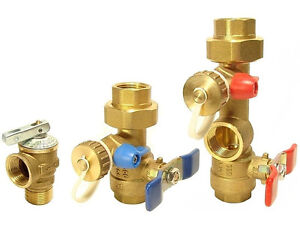I have an Iheart S16 Drakken electric tankless water heater to install.
The provided installation instructions say to "always install 36" of copper pipe to inlet and from outlet of the heater to insulate heater from any plastic pipe...not using will void warranty..."
Why does the heater need to be insulated from the plastic pipe? Certainly, CPVC can handle the heat.
Why would it need this 36" of copper pipe on the cold side?
The "installation kit" is 2 valves with taps and a pressure relief valve,
 which seems to only be available in 3/4 inch. (The heater has 1/2 inch connections.)
which seems to only be available in 3/4 inch. (The heater has 1/2 inch connections.)
The tap on the hot valve is for the pressure relief valve.
But what is the tap on the cold valve for? On pictures of an installed heater, sometimes that isn't there.
The provided installation instructions say to "always install 36" of copper pipe to inlet and from outlet of the heater to insulate heater from any plastic pipe...not using will void warranty..."
Why does the heater need to be insulated from the plastic pipe? Certainly, CPVC can handle the heat.
Why would it need this 36" of copper pipe on the cold side?
The "installation kit" is 2 valves with taps and a pressure relief valve,

The tap on the hot valve is for the pressure relief valve.
But what is the tap on the cold valve for? On pictures of an installed heater, sometimes that isn't there.
Last edited:





